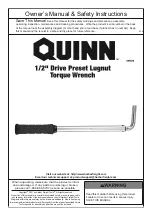
15
Each knife insert has an etched reference mark
so that you can keep track of the rotations.
IMPORTANT:
When removing or rotating
inserts, clean saw dust from the screw, the
insert, and the cutterhead platform. Dust
accumulation between these elements can
prevent the insert from seating properly, and
may affect the quality of the cut.
Before installing each screw, lightly coat the
screw threads with machine oil and wipe off any
excess.
Securely tighten each screw which holds the
knife inserts before operating the planer!
Make sure all knife insert
screws are tightened securely. Loose inserts
can be propelled at high speed from a
rotating cutterhead, causing injury.
Gib Adjustment
After a period of use, the gibs may become
loose and need adjusting:
1. Loosen three lock nuts (A, Fig. 27) and gib
lock screw (B, Fig. 27)
2. Tighten each set screw 1/4 turn starting at
the bottom and working up. If a 1/4 turn
does not remove all play, take another 1/4
turn. Repeat a 1/4 turn at a time for all three
set screws until play is removed.
3. Tighten lock screw (B, Fig. 27) and lock nuts
(A, Fig. 27).
Operation
Keep all guards in place and
in adjustment at all times during the cutting
procedure! Keep hands away from the
cutterhead! Do not pass hands directly over
the cutterhead! The use of push sticks
and/or handle pads are highly recommended
when using the jointer! Failure to comply
may cause serious injury!
Jointing cuts or edge jointing are made to
square an edge of a workpiece. The workpiece
is positioned on the jointer with the narrow edge
of the workpiece on the infeed table and the
major flat surface of the workpiece against the
fence (Fig. 28).
Planing cuts are similar. The major surface of
the workpiece is placed on the table with the
narrow edge of the workpiece against the fence
(Fig. 29).
Figure 27
Figure 28
Figure 29
















































